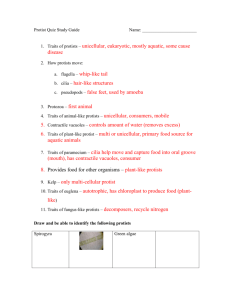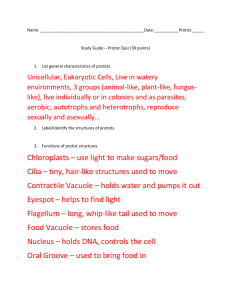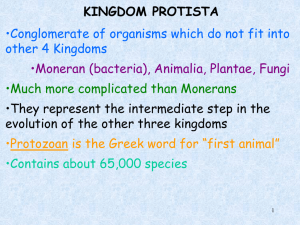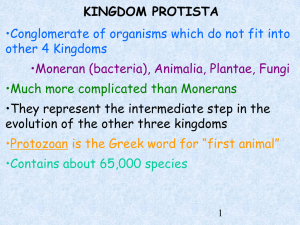Animal-like protists
advertisement
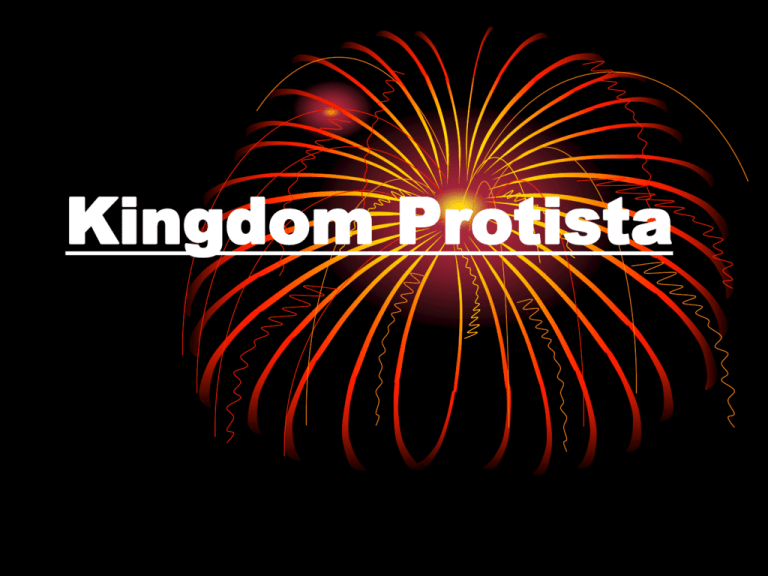
Kingdom Protista General Characteristics • Eukaryotic cell structure • Some unicellular, others multicellular • Some carry on photosynthesis make their own food like plants Some ingest food - like animals • Some absorb food - like fungi 3 categories of Protists •Animal-like •Fungus-like •Plant-like Animal-like protists: PROTOZOANS •All heterotrophs •classified by the 4 ways they move: 1) Cilia - tiny beating hair-like structures •Coordinated movement between individual cilia 2) Flagellum(a) - whip-like tail(s) •Back and forth wave motion Animal-like protists •classified by the 4 ways they move: 3) Pseudopodia - projection of cytoplasm that sticks out like a foot (“false foot”) 4) Sessile - No locomotion (_________) movement Animal-like protists Example 1. Amoeba comes from the Greek word amoibe which means “change” unicellular moves by pseudopodia which give appearance of cell changing size and shape aquatic - lives in ponds, ditches or slowly moving streams can cause disease – amoebic dysentery ingests small organisms like bacteria and other protozoans Animal-like protists - Sarcodines 1. Amoeba feeding sequence psuedopodia surround and engulf food particle, and this process called phagocytosis Animal-like protists - Ciliates 2. Paramecium •Unicellular, slipper-shaped •move by coordinated beating of many cilia •aquatic - mostly found in ponds and streams •usually do not cause diseases in humans Animal-like protists - Ciliates 2. Paramecium - continued •Feeding occurs in the funnelshaped gullet (buccal cavity) where food is drawn in by external and internal cilia to form food vacuole •ingests organic detritus and other small organisms like bacteria and other protozoans Animal-like protists - Ciliates 2. Paramecium - continued •Reproduction 1. Binary fission (________) asexual N = nucleus F = Fission plane Animal-like protists - Ciliates 2. Paramecium - continued •Reproduction 2. Conjugation (________) sexual •Form structure called conjugation tube to exchange genetic material Animal-like protists: The Sporozoan Characteristics of Sporozoans (Animal-like) •Sporozoa do not move on their own •mostly common in tropical areas •Protist reproduce by forming spores •They are parasitic •Diseases •Malaria: sporozoan carried by mosquitos •Africa sleeping sickness: zooflagellate, carried by a fly. Amebic dysentery: zooflagellate, carried by dirty PLANT-LIKE PROTIST •Have chlorophyll •Make their own food •They can live in 4 main environments: •soil •freshwater •tree bark •salt water •they produce large amounts of oxygen which are used by other living organisms •they are grouped according to color & stucture •into 5 main groups: 2) diatoms 3) dinoflagelletes 1) euglena 4) red dinoflagellates 5) algae PLANT-LIKE PROTIST Cont’d •They are grouped according to color & stucture A) Euglena B) Diatom C) Dinoflagellates D) Red Dinoflagellates E) Green Algae PLANT-LIKE PROTIST Cont’d A) Euglena•Unicelluar alga that moves with one flagellum •lives in fresh water •reproduces asexually •red eyespot near front end to find light…Why? to direct light to chloroplast. •have chlorophyll and can make their own food (autotroph ) PLANT-LIKE PROTIST Cont’d B) Diatom •beautiful unicelluar protists •come in many shapes •EX: boats, rods, disks, triangles •important food source for water dwelling animals •made of the same material as glass •used for toothpaste, scouring powders, & filters PLANT-LIKE PROTIST Cont’d C) Dinoflagellates •Half are photosynthetic, and the others are heterotrophs. •Most reproduce by binary fission. •Move by two flagella •Algae that is usually found in oceans PLANT-LIKE PROTIST Cont’d E) Green Algae •can be unicellular or multicellular •they produce oxygen in water. spirogyra •serve as food for fish, snails, and crayfish •Found in fresh and salt water. •Colony – a group of cells that live together Share many characteristics with plants including their photosynthetic pigments and cell wall composition PLANT-LIKE PROTIST Cont’d Algae Examples •Algae reproduce through a process called alternation of generations –It is the switch back and forth between haploid and diploid stages during their life cycle. •EX: Kelp (brown algae) HUMAN USES OF ALGAE • Produce much of the earth’s oxygen through photosynthesis. • Chemicals in algae are use to treat stomach ulcers, high blood pressure, and arthritis. • Used in Sushi rolls ,ice cream, salad dressing, pudding candy bars and pancake syrups • Used to make plastics, waxes, transistors, deodorant, paints lubricants and artificial wood FUNGUS-LIKE PROTIST Slime Molds: •fungus-like protists that are consumers •live in cool, damp places EX: forest floor •feed on bacteria growing on rotting logs and decaying leaves •some are parasites (very few) Plants, Fungi & Animal Cells • Plants Only • Animals Only • Cell wall of cellulose • Central vacuole • Chloroplasts • Lysosomes • Centrioles Fungi Only – Cell wall of chitin – Central vacuole – No chloroplasts Directions: Write out & highlight the following questions 1) List the three main (groups) types of protists? 2) Give two examples of animal-like protists. 3) What are sporozoans? Give one example. 4) List the 3 structures protozoan use for locomotion. 5) List 5 plant-like protists? 6) Why are algae important?


